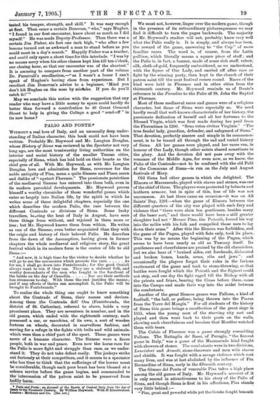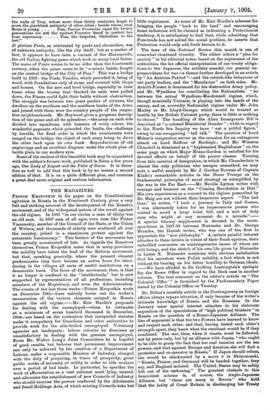whose History of Siena was reviewed in the Spectator not
very long ago, are the most trustworthy living authorities on the interior and social history of the smaller Tuscan cities, especially of Siena, which has laid hold on their hearts as the chief gem of all. With Mr. Heywood, as with Mr. Langton Douglas, love and admiration for Siena, reverence for the noble antiquity of Pisa, mean a quite Sienese and Pisan scorn and dislike of "upstart Florence." The passionate patriotism of the mediaeval Sienese has entered into them both, even in its modern parochial developments. Mr. Heywood proves himself a worthy chronicler of those wonderful games which enter so largely into Italian life, by the spirit in which he writes some of these delightful chapters, especially the one which describes the modern Palio, the race between the different Contratle or divisions of Siena. Some lucky travellers, bliAving the heat of Italy in August, have seen these things from without, and rejoiced in them more or less; but Mr. Heywood knows them from within. He writes as one of the Sienese, even better acquainted than they with the origin and history of their beloved Palio. He describes from the dawn of the Assumption, having given in former chapters the whole mediaeval and religious story, the great festival which in its modern form is the centre of life to old Siena :—
"And now, it is high time for the visitor to decide whether he
will go to see the ceremonies which precede the race As for me, I shall go down into Fontebranda; for the good Ocaioli always want to win if they can. They are a stalwart folk, and worthy descendants of the men who fought in the forefront of
the battle on the day of Camollia Nor are their methods less strenuous to-day. With them the end justifies the means ; and if any efforts of theirs can accomplish it, the Palo will be brought to Fontebranda."
To realise the whole thing one ought to know something about the Contrade of Siena, their names and devices. Among them the Contrada dell' Oca (Fontebranda, the district of St. Catherine), referred to above, holds a very
prominent place. They are seventeen in number, and in the old games, which ended with the eighteenth century, each possessed a car, or macchina, of its own, a sort of wooden fortress on wheels, decorated in marvellous fashion, and serving for a refuge in the fights with bulls and wild animals, which were then a chief part of the sport. These games were never of a humane character. The Sienese were a fierce people, both in war and peace. Even now the horse-race for the Palo is more fight and struggle than race, as we under- stand it. They do not take defeat easily. The jockeys strike out furiously at their competitors, and it occurs to a spectator who has time to think that the sufferings of the horses must be considerable, though each poor beast has been blessed at a
solemn service before the game begins, and commended to the- intercession of the patron saint to be preserved from bodily harm.
• Patio and Ponta aw.docownt of the Sports of Centrist Italy from. the Age of Dante to the Tiventieth . By William Heywood. With 27 Illustration& Loudon: Methuen and Co. IsIs. net.] We must not, however, linger over the modern game, though in the presence of its extraordinary picturesqueness we may find it difficult to turn the pages backwards. The majority of Mr. Heywood's readere will not, probably, know very well what the Palio really is. It is simply, and always has been, the reward of the game, answering to "the Cup" of more- familiar races. The word is, of course, from the Latin pallium, which literally means a square piece of stuff ; and the Palio is, in fact, a banner, made of some rich stuff, velvet; silk, cloth-of-gold, frequently embroidered, as we understand, with the figure of Our Lady, and carried off after race or fight by the winning party, then kept in the church of their patron saint till the next festival comes round. Races of the kind were held in Florence and in other cities from the thirteenth century. Mr. Heywood reminds us of Dante's reference in the Paradiso to the Palio of St. John the Baptist at Florence.
Most of these mediaeval races and games were of a religious character, but those of Siena were especially so. We need hardly recall that well-known characteristic of her history, the passionate dedication of herself and all her fortunes to the Blessed Virgin, which was first made during her peril from the Florentines in 1260. "Sena vetus civitas Virginia." "The true feudal lady, guardian, defender, and safeguard of Siena." That devotion, perfectly sincere and simple in its commence- ment, is to be traced all through the sad and varied history of Siena. All her games were played, and her races run, in honour of Our Lady, though other saints shared sometimes in the glory. And the devotion did not pass away with the romance of the Middle Ages, for even now, as we know, the Palio of the C,ontrade—not to be confused with the old Palii of the Commune of Siena—is run on the July and August festivals of Mary.
Old Siena had other games in which she delighted. The
• Elmora or Mazzascudo, played with staves and stones, was one of the chief of these. The players were protected by helmets and leathern armour, but in spite of this, loss of life was not uncommon. At last there came an occasion—it was on All Saints' Day, 1291—when the game of Elmora between the 4ifferent quarters of the city was played with such fury and, violence that "there were slain ten gentlemen, besides many, of the baser sort," and there would have been a still greater slaughter had not "Messer Pino, the Potesth, forced his way into the melee with his folk and compelled those men to lay down their arms." After this the Elmora was forbidden, and the game of the Pugna, played with fists only, took its place.. This was by no means the beginning of the Pugna, which seems to have been nearly as old as Tuscany itself. Its gentleness and cheerfulness are praised by the old chroniclers, but we also hear of "bruised sides, cut foreheads, dislocated and broken bones, bands, arms, ribs and jaws " : and occasionally the players forgot their rules in the furious excitement of the game and took to stone-throwing, so that battles were fought which the Potesta and the Signori could not stop, and one day the fight raged till the Bishop with all the priests and friars, bearing the Cross before them, came into the Campo and made their way into the midst between the combatants.
Another of the great Sienese games was Pallone, a kind of football, "the ball, or pallone, being thrown into the Piazza from the Torre del Mangia." For all students of the history of Siena this game brings a recollection of the great siege in 1555, when the young men of the starving city met and played and then went back to their posts on the walls, showing such cheerfulness and heroism that Montluc watched them with tears.
The Calcio of Florence was a game strongly resembling Pallone. The Battaglia de' Sassi, of Perugia, "the fiercest game in Italy," was a game of the 3fazzascudo kind fought with showers of stones. The combatants were in two divisions, Lanciatori and Armati, stone-throwers and men with staves and shields. It was fought with a savage violence which cost many lives, and was at last abolished by the influence of Fma Bernardino of Siena, early in the fifteenth century.
The Giuoco del Ponte of venerable Pisa takes a high place among the old games of Italy. Mr. Heywood's account of it is only second in attractiveness to his story of the Palio of Siena, and though Siena is first in his affections, Pisa stands very little behind :—
" Pisa, great and powerful while yet the Greeks fought beneath Rome is young Pisa, Tusciae Provinciae caput for twelve generations ere yet the upstart Florence dared to contest her
hoar supremacy Pisa, the Imperial, Ghibelline to the
glorioso Ponte, as celebrated by poets and chroniclers, was
of unknown antiquity, like the city itself ; but as a matter of fact, it appears to have been a variant of the Mazzascudo, the old Italian fighting game which took so many local forms. The name of Ponte seems to be no older than the fourteenth century, when the game came to be "a mimic battle, fought on the central bridge of the City of Pisa." This was a bridge built in 1383: the Ponte Vecchio, which preceded it, being of wood, with foundations only of stone, and covered with shops and houses. On the new and level bridge, especially in later times when the houses that blocked its ends were pulled down, the Pisans could fight their battle without obstruction.
The struggle was between two great parties of citizens, the dwellers on the northern and the southern banks of the Arno, and joined with them were the country people of the respec- tive neighbourhoods. Mr. Heywood gives a gorgeous descrip- tion of the game and all its splendour,—the army on each side divided into squadrons, with banners of every colour, the wonderful pageants which preceded the battle, the challenge by heralds, the fixed order in which the combatants were ranged on the bridge, the object of each army being to drive the other back upon its own bank. Reproductions of old engravings and an excellent diagram make the whole plan of battle plain to our modern eyes.
Some of the readers of this beautiful book may be acquainted with the author's former work, published in Siena a few years
ago, Our Lady of August and the Patio of Siena. It is there- fore as well to add that this book is by no means a second
edition of that. It is on a quite different plan, and contains a great deal more original and curious information.
THE MAGAZINES.















































 Previous page
Previous page